MARQUESAS
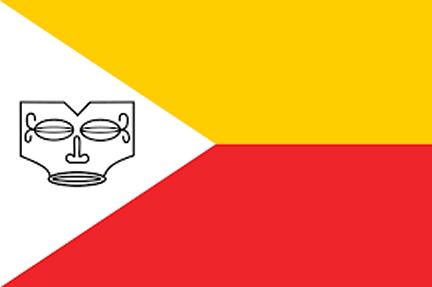
Little is known of the pre-European history of the Marquesas. However, archaeologists have determined that the Marquesas were the first island group to be inhabited in what is now French Polynesia. The first inhabitants were probably from Samoa and Tonga, and they likely arrived by canoe as early as the 3rd century AD. Although the Society Islands and Tuamotus are closer to Samoa and Tonga, it is believed that the Marquesas were inhabited first because their elevation caused them to be the most likely to be seen from sea.
Archaeological remains suggest that the early Marquesans were warriors, but they were also artistic. Many weapons and much creative art has survived the centuries.
The islands that would become known as the Marquesas were first spotted by a European in 1595. The Spaniard Alvaro de Mendana de Neira visited the southern islands of Tahuata, Fatu Hiva, Hiva Oa, and Moho Tani. Mendana named the islands after his patron, Marques de Canete. The northern islands were not seen by western explorers until the American fur trader, Joseph Ingraham, spotted them in 1791. Ingraham called the islands the Washington Islands, but obviously the name did not last. All of the islands were known by 1791.
According to local legend, the gods created the islands as their home. Consequently, all island names are aspects of building a house.
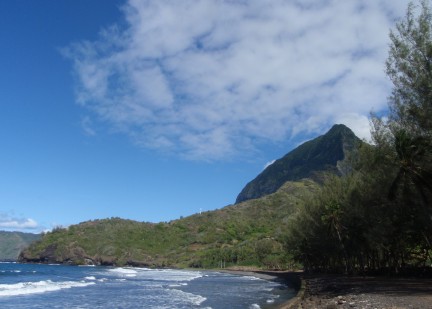
Atuona, Hiva Oa
In 1813, Commodore David Porter claimed the island of Nuku Hiva for the United States. However, congress never ratified the claim. In 1842, France took possession of the entire group. Of the islands now comprising French Polynesia, the Marquesas were the first group to fall under French sovereignty.
In the 19th century, the colonizers developed a plantation economy growing mostly coffee and cotton. In the 1860s, workers were imported from Martinique and China. However, erratic rainfall led to the demise of the plantations. Most of the imported labor force returned home, but not all.
The Marquesas were once a heavily populated thriving group. However, among the island groups now comprising French Polynesia, the Marquesas suffered the greatest population decline from disease introduced by Western explorers. The population in the 16th century – prior to Mendana’s arrival – has been estimated to be more than 100,000. In the 18th century, it was still 60,000 to 80,000. Then smallpox arrived. By the mid-19th century, the population had decreased to approximately 20,000, and by the beginning of the 20th century, the population was less than 2,000. They lost more than 98% of their people.
The Marquesas are a geographically isolated group of mountainous volcanic islands (one island – Motu One – is not volcanic). They are 850 miles from Tahiti and 3,000 miles from Mexico – the nearest continental landmass. Like most Pacific island groups, they run southeast to northwest. They span from 8.0 to 10.35 degrees north and 138.25 to 140.50 degrees west. They are geologically the youngest group of the French Polynesia islands, and, contrary to other Pacific island groups, they have little fringing coral growth.
Depending on how one determines whether a landmass is a rock or an island, there are between 12 and 15 islands. They fall in to two geographic groups – the northern islands and the southern islands. There are also associated seamounts around the northern islands. They are elevated islands ranging from 1,300 to more than 4,000 feet of elevation, and they have deep fertile soil. Their total land mass is 405 square miles.
There are no indigenous land animals, but many animals – sheep, cattle, pigs, horses, goats – were imported then left behind by plantation workers in the 19th century. Those now wild animals have become a problem for the islanders. There are many indigenous birds and fish and some very big sharks.
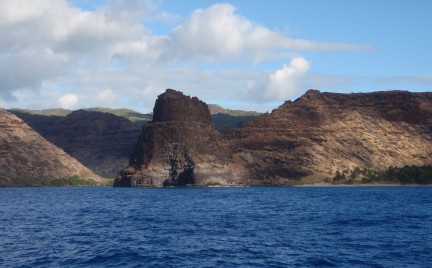
Baia de Hanamenu, Hiva Oa
Although much of the islands is green and lush with foliage, the Marquesas experience frequent droughts. These droughts have created historic fluctuations in water availability, and that has influenced where people have settled. All the islands are capable of supporting habitation, only six are inhabited. Those include the northern islands of Nuku Hiva, Ua Pou, and Ua Huka and the southern islands of Tahuata, Fatu Hiva, and Hiva Oa.
The population has been on a slow but persistent increase since its nadir at the beginning of the 20th century. In 2002, the population was 8,548. In 2012, it had increased to 9,264.And that population is remarkably ‘home grown’. More than 70% of the population was born in the Marquesas, 24% was born in other parts of French Polynesia, and 5% was born in France or other French territories. Less than 1% of the population was born in other foreign countries.
Like other islanders in French Polynesia, most Marquesans speak multiple languages. Nearly all speak French and Marquesan. There are two dialects of Marquesan – a northern dialect and a southern dialect. Many also speak Tahitian – particularly those that went to school in Tahiti. Very few speak any English. Marquesan is the language spoken in more than two thirds of homes.
Like all of French Polynesia, the currency is the French Polynesian Franc (XPF). One US dollar is equivalent to approximately 91 XPF.
The Marquesas are one of the administrative divisions of French Polynesia. However, their relationship with Tahiti is somewhat strained.
Many Marquesans feel that they are neglected by Tahiti, and many favor a direct link to France rather than being under the French Polynesian government in Tahiti. French Polynesia is moving toward independence from France, but the Marquesas do not want that degree of independence, and many want to stay affiliated with France. Some Tahitians accuse the French of encouraging the Marquesas to secede from French Polynesia.
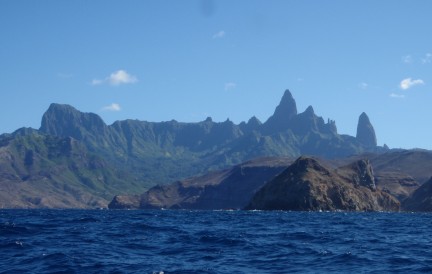
Ua Pou
The Marquesas do not have a provincial or regional assembly. Most governmental decisions are made by the government appointed Administrator.
Atuona, on the island of Hiva Oa, was the previous capital of the Marquesas. However, Taiohae, on Nuku Hiva, is now the administrative center.
We visited three islands in the Marquesas – Hiva Oa, Ua Pou, and Nuka Hiva. We found many differences but even more similarities.
There are no manmade harbors in the Marquesas, but a few of the natural harbors have built small breakwaters. Unfortunately, swell finds its way in to most bays causing boats to roll – sometimes uncomfortably. Stern anchors are a necessity in most bays, and boats still bounce and roll uncomfortably. That was our experience on all three islands that we visited.
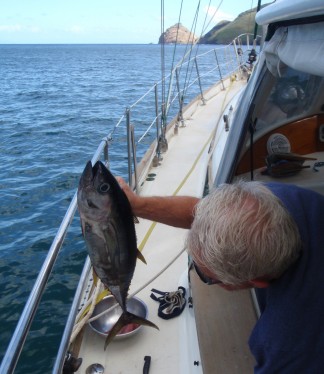
Tuna just outside Taiohae, Nuku Hiva
Hiva Oa means ‘long ridgepole’ in the Marquesan language. It is the most fertile of the southern Marquesan islands. It is known for being the final home of French painter Paul Gauguin and Belgian singer Jacques Brel.
The topography of Hiva Oa includes steep cliffs along the coast that rise to an interior spine of rugged volcanic rock with deep valleys. Most of the coastal terrain is too rugged to build roads. Its most dramatic topography is the collapsed volcano Temetiu which forms the semi-circular Baie de Taaoa with 3,300 foot walls.
We made landfall in Baie de Taaoa just outside the island’s capital of Atuona. The bay has a small breakwater, but it does little to slow the swell inside that causes boats to roll. There were ten boats at anchor when we arrived, and another two arrived. There were 13 boats including Passage, and the anchorage was crowded. We anchored far inside, including a stern anchor, and we were uncomfortably close to another boat.We moved as soon as another boat left and a space opened. But even with a stern anchor, we bounced and rolled too much to clean our hull which needed it desperately after our long passage.We got less than half of it cleaned before we gave up and left it for another anchorage – hopefully a calmer one. Baie de Taaoa is also known to be home to many large sharks.
The population of Hiva Oa is 2,200. Like all of the Marquesas, Hiva Oa is a mountainous island. It is approximately 23 miles long by 10 miles wide. Its highest peak is Mount Temetiu at 4,186 feet. The southern coast – where Atuona is – is dense with vegetation and very green. It is very pretty scenery. It is, however, also infamous as the last stronghold of cannibalism in French Polynesia.
Atuona has a few small stores, and the basics are available. However, no one on island could fill our propane tank. That would have to wait until Nuku Hiva.
The population of Hiva Oa is 2,200. When walking between town and the anchorage, one of the friendly islanders would usually stop and give us a ride. One car that picked up Bud one day was driven by a young man named Pifa. Pifa went to school on Oahu, and he was excited to meet someone from Hawaii. Pifa also does tours of the island, and he gave Bud his phone number to call if we wanted a tour of the island. We did call a few days later, but Pifa wanted the equivalent of $300 USD for a partial day tour. We declined.
Everything on Hiva Oa was exceptionally expensive. Although we had done much of our laundry underway while on passage, we did not wash linens – sheets and towels. We had them washed on Hiva Oa for the equivalent of $53.57 USD.
Bud had previously visited Hiva Oa in 1987, and we went in search of a couple that had befriended him then – Jean Claude and Ester. We asked around and learned that Jean Claude had died about 15 years ago, and Ester was in Tahiti. We were not clear if she was just visiting or living there. Through coincidence we met their daughter, Pascal. We arranged to meet with Pascal again the following day to give her some pictures we had from Bud’s 1987 visit, but Pascal did not show. Jean Claude and Ester also had a son, Francois, who worked in a government office on island. We took the pictures there. Francois was not in the office, but we left them there for him.
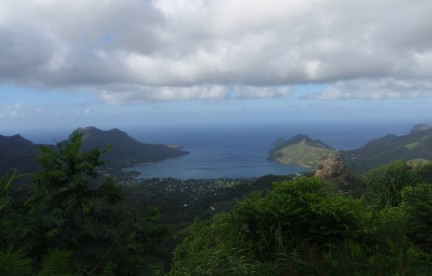
Overlooking Baie de Taiohae, Nuku Hiva
We did not make contact with Jean Claude and Ester, and we were unable to fill our propane tank or even clean our hull. The rolly anchorage was wearing on us, so we decided to move on.On July 17, we left Baie de Taaoa and headed for the northwest corner of the island where we would spend a night or two before going further north.
It took us 3 hours to travel the 17 miles to Baie de Hanamenu. We had dolphins with us for part of the trip. And we noticed a dramatic change in scenery as we went. The lush green foliage disappeared, and dramatic dry scenery emerged.
Baie de Hanamenu was a very quiet bay with no other boats. There were only a few small houses on the beach. At night there were no lights, and it was remarkably dark. Looking back, we probably should have stayed a few days/nights to enjoy the relative calm of the bay, but we stayed only one night, and we left at 0500 local time the next morning – July 17 – and headed for Ua Pou.
We were pleased to have dolphins with us again for part of our sail from Hiva Oa to Ua Pou. The wind was almost deaf aft, and it was mostly less than 15 knots. We also caught a large mahi mahi and got it alongside the boat, but we lost it while trying to land it.
Ua Pou is part of the northern Marquesas, and it is the third largest island of the archipelago after Nuku Hiva and Hiva Oa. It is comprised of 40.5 square miles of extremely dramatic terrain of peaks and ridges. It is roughly diamond shaped – 10 miles long and 7 miles wide. The center of the island is comprised of 4 basalt pillars including Mount Oave at 4,042 feet – the highest point in the archipelago. These dramatic peaks are visible from miles away.
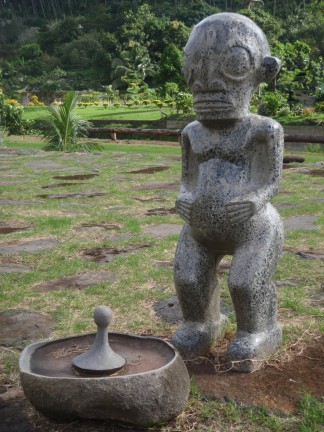
Ua Pou was the most populous island in the Marquesas until the 1980s. In the 17th and 18th centuries, the Catholic priests would quarantine the island’s residents inside the church when ships arrived to avoid contact with the diseases brought by the ships. Ua Pou did not experience the drastic population declines that other islands experienced. Ua Pou’s current population is approximately 2,000, and at least half of that population lives in Hakahau Village.
We anchored in Baie de Hakahau on the northwest coast of the island. The anchorage is only 20′ deep, and there were only three boats there when we arrived. We thought that this would be an easy anchoring experience. However, winds shift often as they pass through the steep terrain, and we noticed that the boats were swinging far more than we would expect. We found a spot clear of the swing of the other boats. Shortly thereafter, the owners of one of the boats came over and told us that we were too close to them. They had 200′ of chain out in a 20′ anchorage! We politely told them that we would stay where we were. We are conscientious about our anchoring practices, and we did not take kindly to someone with a 10:1 scope in a calm anchorage telling us how to anchor.
We stayed one night in Baie de Hanamenu. We left for Nuku Hiva on July 17.
We had a fast and bumpy trip from Ua Pou to Nuku Hiva. Just outside the anchorage on Ua Pou we had 18 to 22 knots of wind forward of the beam and bumpy seas. Here we go again… We had a big fish strike shortly after leaving Ua Pou, but we did not get the fish. We bounced along and caught two tunas about four miles off Nuku Hiva – shortly before we planned to bring in our fishing gear. We landed both of these. Our friends, Jesse and Shay on SV Big Rock, were in the anchorage at Baie de Taiohae, so we gave them one of the fish.
Nuku Hiva is the largest island in the Marquesa archipelago with 127 square miles of land, and it is the second largest island in all of French Polynesia with only Tahiti being larger. It was formed by two volcanoes imbedded in each other. Its terrain includes tropical coastline, desert, pine forests, and grass prairie. Nuku Hiva’s highest point is Mount Tekao at 4,016 feet.
Taiohae is the administrative center and largest town in the Marquesas. Most of its population of 2,600 live in the village of Taiohae at the mouth of the bay. Almost 93% of their population was born in French Polynesia, and almost 6% was born in France. Less than 2% of the population is foreign born
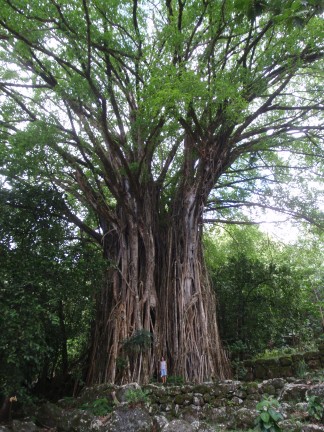
Huge banyan tree with Nita at its base
We went in to Baie de Taiohae on the southern coast. This bay is formed by the open remains of a volcanic crater with the caldera walls surrounding. This was another rolly bay. We anchored in 32′ of water with a bow and stern anchor. We reset the stern anchor three times in the next 24 hours and a few more times after that. We saw many lemon sharks and manta rays inside the bay during our stay.
We stayed busy during our time in Nuku Hiva. We cleaned the boat (still rough, but better than Hiva Oa) and took care of some projects. We met Kevin at Yacht Services Nuku Hiva. He is an American expat and former cruiser that has been living on Nuku Hiva for six years. He established a business catering to cruising sailors, and he is a jewel. Kevin fixed our laptop, filled our propane, got us an impeller for our 2 hp outboard motor, and provided a laundry service. He also rents cars. We shared a car rental with two other boats and had a wonderful day exploring the island.
Six of us piled in to a four-wheel drive pick up (two in the back), and we drove in a somewhat counter-clockwise direction on roads ranging from intact pavement to a “goat path”. Along the way, we enjoyed the terrain and empty bays. We saw many goats, pigs, horses, and cattle. We visited Taipivai, Hatihe’u, and ‘A’akapa. Taipivai is the largest cultural valley in Nuku Hiva. It has many stone tiki, petroglyphs, me’ae (religious sites), and paepae (stone platforms upon which people lived). Herman Melville wrote his book, Typee, based on his experiences in Taipivai. Hatihe’u is known for a statue of the Virgin Mary that was lifted 1,000’ up a rock to overlook the bay below. ‘A’akapa is a small village noteworthy for its beautiful setting. It also has interesting archaeological sites.
We went to watch Marquesan dancers on two nights – one mostly women and one mostly men. The women do a whole lot of hip shaking. That part of the hula is pretty much constant in their dances. We thought that it was energetic and sometimes overtly sexual, but it was not as aesthetically appealing as the Hawaiian hula with which we are more familiar. We did not enjoy the men’s hula. It is too aggressive – much like the New Zealand Maoris. It, too, is very high energy, but we did not enjoy it.
There were two small groceries in the town of Taiohae, and we also found adequate fresh fruits and vegetables to provision for our trip to the Tuamotus. After ten days on Nuku Hiva, we were ready to move on.
We left the Marquesas with mixed feelings. The islands are beautiful – no doubt about that. But we think that they see too many cruising boats there. We never felt particularly welcome other than our money. We felt like we were just more tourists passing through. It was mostly an impersonal place. This is a change from the friendliness that Bud found 27 years earlier. What will we find in the Tuamotus?
Sail with us from the Marquesas to the Tuamotus
or jump ahead to the Tuamotus or the Society Islands